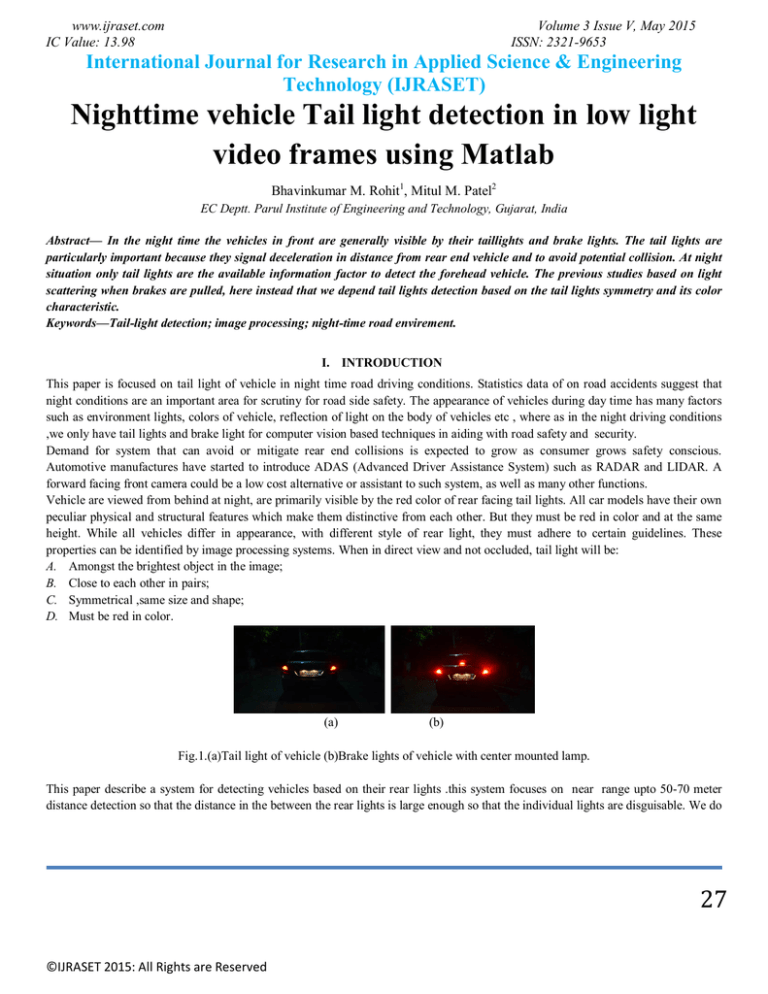
www.ijraset.com
IC Value: 13.98
Volume 3 Issue V, May 2015
ISSN: 2321-9653
International Journal for Research in Applied Science & Engineering
Technology (IJRASET)
Nighttime vehicle Tail light detection in low light
video frames using Matlab
Bhavinkumar M. Rohit1, Mitul M. Patel2
EC Deptt. Parul Institute of Engineering and Technology, Gujarat, India
Abstract— In the night time the vehicles in front are generally visible by their taillights and brake lights. The tail lights are
particularly important because they signal deceleration in distance from rear end vehicle and to avoid potential collision. At night
situation only tail lights are the available information factor to detect the forehead vehicle. The previous studies based on light
scattering when brakes are pulled, here instead that we depend tail lights detection based on the tail lights symmetry and its color
characteristic.
Keywords—Tail-light detection; image processing; night-time road envirement.
I. INTRODUCTION
This paper is focused on tail light of vehicle in night time road driving conditions. Statistics data of on road accidents suggest that
night conditions are an important area for scrutiny for road side safety. The appearance of vehicles during day time has many factors
such as environment lights, colors of vehicle, reflection of light on the body of vehicles etc , where as in the night driving conditions
,we only have tail lights and brake light for computer vision based techniques in aiding with road safety and security.
Demand for system that can avoid or mitigate rear end collisions is expected to grow as consumer grows safety conscious.
Automotive manufactures have started to introduce ADAS (Advanced Driver Assistance System) such as RADAR and LIDAR. A
forward facing front camera could be a low cost alternative or assistant to such system, as well as many other functions.
Vehicle are viewed from behind at night, are primarily visible by the red color of rear facing tail lights. All car models have their own
peculiar physical and structural features which make them distinctive from each other. But they must be red in color and at the same
height. While all vehicles differ in appearance, with different style of rear light, they must adhere to certain guidelines. These
properties can be identified by image processing systems. When in direct view and not occluded, tail light will be:
A. Amongst the brightest object in the image;
B. Close to each other in pairs;
C. Symmetrical ,same size and shape;
D. Must be red in color.
(a)
(b)
Fig.1.(a)Tail light of vehicle (b)Brake lights of vehicle with center mounted lamp.
This paper describe a system for detecting vehicles based on their rear lights .this system focuses on near range upto 50-70 meter
distance detection so that the distance in the between the rear lights is large enough so that the individual lights are disguisable. We do
27
©IJRASET 2015: All Rights are Reserved
www.ijraset.com
IC Value: 13.98
Volume 3 Issue V, May 2015
ISSN: 2321-9653
International Journal for Research in Applied Science & Engineering
Technology (IJRASET)
not account for vehicles that do not meet legislation requirements, such as vehicles with modified lights or broken lights that do not
meet the common legal specification of color, brightness and position
In the proposed system ,introduced low light video frames which are low exposure value images , by using the low exposure image
frames many factors such as street lights, unwanted reflections from vehicles body ,sign boards reflections can be removed and only
the bright red color and head lights of oncoming vehicles are visible in the image frame.
To reduce the interference from environmental lighting sources such as street lights and signboards, a color filter is used for verifying the
detected lights. The trichromatic coordinates specifying the regulation color for red lights are defined by the following inequalities:
x+y≥ 0.
y≤ 0.335
Fig.2.CIE xy chromatically diagram showing the regulation limits of light for red taillight signals.
II. LEGISLATION
Over the world automotive industry legislation provided that rear vehicle light must be red and placed symmetrically in pairs at the
same height of the rear of the vehicle. This must be wired so they light up whenever the front lights are liten up. Also that tail lights
and brake lights can be integrated into a single unit, there is specified brightness ratio for distinguish the tail and brake lights. The tail
light can be of LED bulb also.
III. METHODOLOGY
Input Image Frame
Tail light color filtering
Light blob extraction
Paring each blob
Horizontal edge detection
Symmetry check
Vehicle present
Fig.2. system flow for tail light detection and verification of the same vehicle.
28
©IJRASET 2015: All Rights are Reserved
www.ijraset.com
IC Value: 13.98
Volume 3 Issue V, May 2015
ISSN: 2321-9653
International Journal for Research in Applied Science & Engineering
Technology (IJRASET)
Here steps are decided to detect the red color tail light so the approach is applied with firstly extracting the Red Layer from the RGB
frame then getting the gray converted image of the input frame. After getting the gray frame subtract the gray frame from the Red
frame. All the unwanted noises are removed using Median Filter Last, the convert the frame into Binary Image using Threshold value.
Now put the blob analysis on the image frame to calculate the area and bounding box of those blobs.
(a)
(b)
(c)
(d)
(e)
Fig.2. (a) original image frame (b) Red color frame (c) gray converted image (d) Removed noise image (e) binary converted image
frame
To pair the light blob, connected component analysis is applied to label each candidate in order to characterized parameters. After that
blob candidate are paired with other to determine the symmetry between them. Depending upon the symmetry of the tail lights are
identify as for a same vehicle and other blobs are rejected as a nuisance light spots.
IV. EXPERIMENTAL RESULTS
The system has been performed with four different type of road conditions where the ratio of traffic is different, with the urban traffic
situations, unwanted light sources such as various traffic sign boards and street lights are came into the frame, where in the case of
rural traffic as the vehicles are very less compared to urban traffic the detection is more reliable.
(a)
(b)
(c)
Fig.3.(a)Urban Traffic frames (b) binary converted frames (c)Detected tail lights
(a)
(b)
(c)
Fig.4.(a)Two way Traffic frames (b) binary converted frames (c)Detected tail lights.
29
©IJRASET 2015: All Rights are Reserved
www.ijraset.com
IC Value: 13.98
Volume 3 Issue V, May 2015
ISSN: 2321-9653
International Journal for Research in Applied Science & Engineering
Technology (IJRASET)
(a)
(b)
(c)
Fig.5.(a)Highway Traffic frames (b) binary converted frames (c) Detected tail light.
V. QUANTATIVE PERFORMANCE EVALUTION
for performance comparison ,the proposed work is the perform the tail light detection, particularly in the low light night video
sequences. The red color of the selected as a basic detection through the RGB color Model. This tail light is regarded as the taillights,
and the size is used to determine the distance between the vehicle and the camera mounted rear vehicle.
Table I Camera configuration
Camera configuration
Value
Frame Rate
15
Height
160
Width
320
Bits per pixel
24
Color Model
sRGB
Table II Tail light Detection Rates.
Traffic
Total
Detected accuracy
conditions
frames
frames
Rural traffic
317
270
85.01%
Urban traffic
94
83
88.29%
Two way traffic 264
201
76.13%
Highway traffic 215
150
60.64%
Table III
Maximum Detection Distance. Using four different dataset of urban, rural, two way and highway traffic conditions.
Traffic
video
Video1
Video2
Video3
Video4
10m
20m
30m
40m
50m
º
º
º
º
º
º
º
º
º
º
º
º
º
º
º
º
º
º
In addition, to evaluate the system performance under different traffic and road environment condition, data set of image frames are
verified and tested. The detection rata are shown in table.
30
©IJRASET 2015: All Rights are Reserved
www.ijraset.com
IC Value: 13.98
Volume 3 Issue V, May 2015
ISSN: 2321-9653
International Journal for Research in Applied Science & Engineering
Technology (IJRASET)
The system has been tested with 2.5GHz CPU. And the system has made detection on 15frames/s on Windows based platform with
Matlab software. That means the system can be performed in near real time on vehicle based camera systems.
VI. CONCLUSION
Our proposed system can make detection on 15fps rate which is very near for real time applications. Now for the future work we will
try to detect the brake light and distance for making the collision avoidance warning for driver assistance.
VII. ACKNOWLEDGMENT
I would like to thank my Guide, Prof. Mitul Patel for continuous motivation and enlightenment on this research work. Without his
help, this is not going to be possible.
REFERENCES
[1]
“Night Time Brake Light Detection Using Nagakami Imaging” Duan-Yu Chen, Yu-Hao Lin, and Yang-Jie Peng, IEEE TRANSACTIONS ON INTELLIGENT
TRANSPORTATION SYSTEMS, pp.1627-1637 VOL. 13, NO. 4, DECEMBER2012
[2]
“Frequency Tuned Taillight-based Night Time Vehicle Braking Warning System” Duan-Yu Chen, and Yang-Jie Peng IEEE SENSOR JOURNAL.,pp. 3285-3292
VOl-12,NO. 11, NOVEMBER 2012
[3]
“Rear-Lamp Vehicle Detection and Tracking in Low-Exposure Color Video for Night Conditions” Ronan O’Malley, Edward Jones, and Martin Glavin, IEEE
TRANSACTIONS ON INTELLIGENT TRANSPORTATION SYSTEMS,pp. 453-462 VOL. 11, NO. 2,JUNE 2010
[4]
“Vehicle Detection In Monocular Night Time Grey-level Videos”, Umesh kumar ,pp-214-219, 978-1-4799-0833-7/13 IEEE 2013.
[5]
“Traffic Safety Basic Facts 2007—Motorways,” Eur. Road Safety Observatory, 2007.
[6]
“Federal Motor Vehicle Safety Std. 108,” Nat. Highway Traffic Safety Admin., Tech. Rep.
[7]
“Regulation no. 7, Uniform Provisions Concerning the Approval of Frontend Rear Position (Side) Lamps, Stop-Lamps and End-Outline Marker Lamps for Motor
Vehicles (Except Motor Cycles) and Their Trailers, ”UN World Forum Harmonization Vehicle Regulations, 1968.
[8]
Z. Sun, G. Bebis, and R. Miller, “On-road vehicle detection: A review”, IEEETrans. Pattern Anal MachIntell.,vol. 28, no. 5,pp.694-711,May2006
[9]
“An effective method of head lampand tail lamp recognition for night time vehicle Detection.” hyun-koo kim,sangong kuk, Minkwan Kim. World academy of
science, engineering and technology vol-4 2010-08-29
[10] “A hybrid method of Vehicle Detection based on computer Vision for intelligent transportation system” Huan Wang and Haichaun Zhang . International journal
of multimedia and ubiquitous engineering. Vol.9 no.6(2014)pp.105-118
[11] [United Nations] Uniform provisions concerning
vehicles
(except
motor
cycles)
and
2012
the
approval of front and rear position lamps, stop-lamps and end-outline marker lamps for motor
their
trailers
Addendum
6:
Regulation
No.
7
Revision
6
November
31
©IJRASET 2015: All Rights are Reserved


